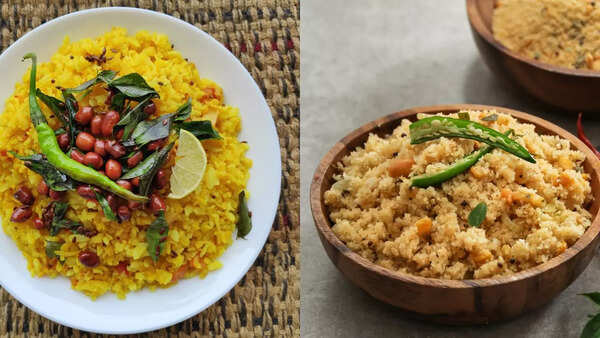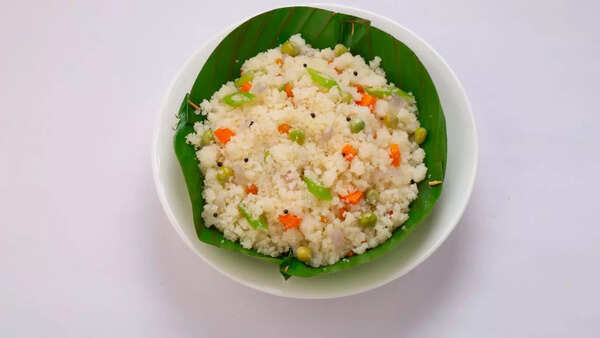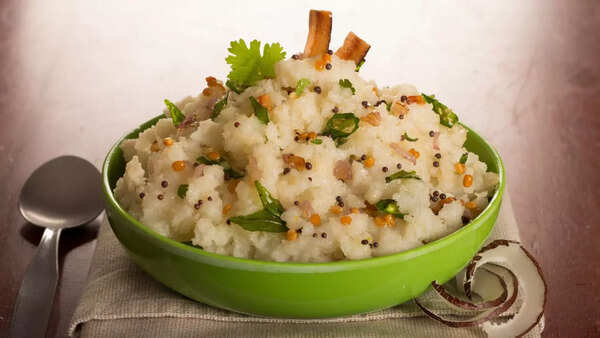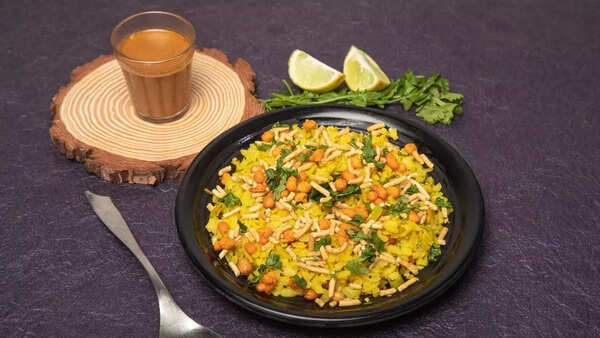Trending
Poha vs Upma: Which is healthier?
Poha, flattened rice, is gluten-free, low-calorie, rich in iron, and easy to digest. Upma, from South India, made from semolina, is high in protein, vitamins, and fiber, ideal for weight watchers. Both breakfast choices' nutrition varies with preparation and vegetables, depending on personal preferences and dietary needs.

Poha and Upma are two of the most loved breakfast choices, known for their unique taste and health quotient. While, both these delicacies are prepared with subtle spices, herbs, vegetables and their simple yet flavorful taste, when it comes to nutrition and health benefits, which one holds the upper hand? Let's delve into the characteristics of each to determine which might be the healthier choice for you.
Poha: Flattened Rice
Poha, also known as flattened rice, is a traditional dish in India made from rice that has been parboiled, rolled, flattened, and then dried to create flakes. There are several ways in which Poha is prepared in different parts of the country. However, as far as the health quotient of Poha is concerned, the taste and calories depend on the way of preparation and ingredients used. Here’s what makes Poha a great breakfast choice:

Poha is relatively low in calories compared to other grains, making it a good option for those watching their calorie intake. In fact, a 100-gram serving of vegetable Poha contains around 130-150 calories. However, the exact calorie count can vary depending on the use of ingredients and method of preparation.
Rich in Iron
Poha contains a good amount of iron, which is important for oxygen transport in the body and overall energy levels.
Gluten-Free
Poha is naturally gluten-free, making it suitable for individuals with gluten intolerance or celiac disease.
Easy to Digest
Due to its flattened and processed nature, Poha is gentle on the stomach and easy to digest, making it a preferred choice for breakfast or a light meal.

Upma: Semolina
Upma is another popular breakfast dish in South India, which is mostly cooked with a melange of assorted vegetables, subtle spices, herbs, dry roasted semolina and peanuts. This light and delicious breakfast recipe is a popular choice among weight watchers and is believed to be one the healthiest South Indian breakfast meals, but when it comes to deciding between Poha and Upma there’s a lot of difference in the calories and nutrients. Here’s all you need to know about Upma and its lesser known benefits.
Rich in Proteins
Semolina used in Upma is relatively high in protein, which is essential for muscle repair, growth, and overall body function.
Good Source of Vitamins
It contains B-complex vitamins like thiamine (B1) and riboflavin (B2), which are important for energy production and metabolism.

Fiber Content
Upma can be made with added vegetables, increasing its fiber content, which aids in digestion and promotes satiety.
Versatile
Due to the versatile taste and texture of sooji, Upma can be made and customized with various vegetables and spices.
Provides Energy
The carbohydrates in upma provide a quick and steady source of energy, making it an excellent option to start your day.
Difference in processing?
Poha and Upma both offer nutritious options, but their processing methods differ. While, flattened rice undergoes minimal processing, mainly soaking and flattening, preserving its nutrient content, including iron and B vitamins. On the other hand, Upma involves roasting and cooking semolina, which can slightly reduce its nutrient density compared to raw semolina. However, both dishes can be made healthier by adding vegetables and using minimal oil. Ultimately, choosing between Poha and Upma for health depends on personal preferences and additional ingredients used in preparation.

Which is Healthier?
Both Poha and Upma are high in nutrition and taste, but the choice between the two can largely depend on individual dietary preferences, health goals, and nutritional needs:
For Calorie-Conscious Individuals: Poha may be preferable due to its lower calorie content and lighter texture.
For Protein and Vitamin Intake: Upma offers a higher protein content and significant B-complex vitamins, making it a nutritious option, especially for vegetarians and vegans.
Digestive Health: Both dishes are generally easy to digest, but Poha's lighter texture may be gentler on sensitive stomachs.
Gluten-Free Requirement: If you need a gluten-free option, Poha is naturally free from gluten.

Classic Poha recipe
To make simple Poha, start by rinsing 1 cup of Poha (flattened rice flakes) under cold water until they soften, then set aside. In a pan, heat 1 tablespoon of oil and add mustard seeds, cumin seeds, curry leaves, chopped green chilies, and diced onions. Sauté until onions are translucent. Add turmeric powder, salt to taste, and mix well. Add the soaked Poha to the pan, stir gently to combine with the spices, and cook for a few minutes until heated through. Garnish with fresh coriander leaves and a squeeze of lemon juice before serving hot.
Here are some popular ways in which Poha can be enjoyed:
1. Classic Poha: Cook flattened rice with onions, green chilies, mustard seeds, turmeric, and peanuts, garnished with fresh coriander and a squeeze of lemon.
2. Vegetable Poha: Enhance classic poha with vegetables like peas, carrots, and potatoes for added nutrition.
3. Poha Chivda: Roast poha with nuts, curry leaves, and spices for a crunchy, savory snack.
4. Poha Tikki: Combine poha with mashed potatoes, spices, and herbs, then shape into patties and pan-fry until crispy.
5. Sweet Poha: Mix poha with milk, jaggery, cardamom, and dried fruits for a delicious dessert or breakfast.
Delicious Upma recipe
To make a tasty vegetable Upma, start by roasting semolina until golden brown in a pan, keep it aside. In the same pan, heat some oil and mustard seeds until they splutter, then add diced onions, green chilies, and curry leaves, and sauté until the onions turn translucent. Next, add chopped vegetables like carrots, peas, and bell peppers, cooking them until tender. Pour in water or vegetable broth, season with salt, and bring it to a boil. Gradually stir in the roasted semolina, mixing well to avoid lumps. Cover and simmer until the Upma is cooked through and fluffy. Garnish with chopped coriander leaves and a squeeze of lemon juice before serving hot.
Conclusion
In a nutshell, it can be concluded that the choice between the Poha and Upma depends on your personal preferences, dietary needs, and health goals. Both dishes are wholesome choices for breakfast or any meal of the day, providing essential nutrients, satiety and comforting flavors, Including them in your diet can help improve improving overall health and well being.
Poha: Flattened Rice
Poha, also known as flattened rice, is a traditional dish in India made from rice that has been parboiled, rolled, flattened, and then dried to create flakes. There are several ways in which Poha is prepared in different parts of the country. However, as far as the health quotient of Poha is concerned, the taste and calories depend on the way of preparation and ingredients used. Here’s what makes Poha a great breakfast choice:

Low in Calories
Poha is relatively low in calories compared to other grains, making it a good option for those watching their calorie intake. In fact, a 100-gram serving of vegetable Poha contains around 130-150 calories. However, the exact calorie count can vary depending on the use of ingredients and method of preparation.
Rich in Iron
Poha contains a good amount of iron, which is important for oxygen transport in the body and overall energy levels.
Gluten-Free
Poha is naturally gluten-free, making it suitable for individuals with gluten intolerance or celiac disease.
Easy to Digest
Due to its flattened and processed nature, Poha is gentle on the stomach and easy to digest, making it a preferred choice for breakfast or a light meal.

Upma: Semolina
Upma is another popular breakfast dish in South India, which is mostly cooked with a melange of assorted vegetables, subtle spices, herbs, dry roasted semolina and peanuts. This light and delicious breakfast recipe is a popular choice among weight watchers and is believed to be one the healthiest South Indian breakfast meals, but when it comes to deciding between Poha and Upma there’s a lot of difference in the calories and nutrients. Here’s all you need to know about Upma and its lesser known benefits.
Rich in Proteins
Semolina used in Upma is relatively high in protein, which is essential for muscle repair, growth, and overall body function.
Good Source of Vitamins
It contains B-complex vitamins like thiamine (B1) and riboflavin (B2), which are important for energy production and metabolism.

Fiber Content
Upma can be made with added vegetables, increasing its fiber content, which aids in digestion and promotes satiety.
Versatile
Due to the versatile taste and texture of sooji, Upma can be made and customized with various vegetables and spices.
Provides Energy
The carbohydrates in upma provide a quick and steady source of energy, making it an excellent option to start your day.
Difference in processing?
Poha and Upma both offer nutritious options, but their processing methods differ. While, flattened rice undergoes minimal processing, mainly soaking and flattening, preserving its nutrient content, including iron and B vitamins. On the other hand, Upma involves roasting and cooking semolina, which can slightly reduce its nutrient density compared to raw semolina. However, both dishes can be made healthier by adding vegetables and using minimal oil. Ultimately, choosing between Poha and Upma for health depends on personal preferences and additional ingredients used in preparation.

Which is Healthier?
Both Poha and Upma are high in nutrition and taste, but the choice between the two can largely depend on individual dietary preferences, health goals, and nutritional needs:
For Calorie-Conscious Individuals: Poha may be preferable due to its lower calorie content and lighter texture.
For Protein and Vitamin Intake: Upma offers a higher protein content and significant B-complex vitamins, making it a nutritious option, especially for vegetarians and vegans.
Digestive Health: Both dishes are generally easy to digest, but Poha's lighter texture may be gentler on sensitive stomachs.
Gluten-Free Requirement: If you need a gluten-free option, Poha is naturally free from gluten.

Classic Poha recipe
To make simple Poha, start by rinsing 1 cup of Poha (flattened rice flakes) under cold water until they soften, then set aside. In a pan, heat 1 tablespoon of oil and add mustard seeds, cumin seeds, curry leaves, chopped green chilies, and diced onions. Sauté until onions are translucent. Add turmeric powder, salt to taste, and mix well. Add the soaked Poha to the pan, stir gently to combine with the spices, and cook for a few minutes until heated through. Garnish with fresh coriander leaves and a squeeze of lemon juice before serving hot.
Here are some popular ways in which Poha can be enjoyed:
1. Classic Poha: Cook flattened rice with onions, green chilies, mustard seeds, turmeric, and peanuts, garnished with fresh coriander and a squeeze of lemon.
2. Vegetable Poha: Enhance classic poha with vegetables like peas, carrots, and potatoes for added nutrition.
3. Poha Chivda: Roast poha with nuts, curry leaves, and spices for a crunchy, savory snack.
4. Poha Tikki: Combine poha with mashed potatoes, spices, and herbs, then shape into patties and pan-fry until crispy.
5. Sweet Poha: Mix poha with milk, jaggery, cardamom, and dried fruits for a delicious dessert or breakfast.
Delicious Upma recipe
To make a tasty vegetable Upma, start by roasting semolina until golden brown in a pan, keep it aside. In the same pan, heat some oil and mustard seeds until they splutter, then add diced onions, green chilies, and curry leaves, and sauté until the onions turn translucent. Next, add chopped vegetables like carrots, peas, and bell peppers, cooking them until tender. Pour in water or vegetable broth, season with salt, and bring it to a boil. Gradually stir in the roasted semolina, mixing well to avoid lumps. Cover and simmer until the Upma is cooked through and fluffy. Garnish with chopped coriander leaves and a squeeze of lemon juice before serving hot.
Conclusion
In a nutshell, it can be concluded that the choice between the Poha and Upma depends on your personal preferences, dietary needs, and health goals. Both dishes are wholesome choices for breakfast or any meal of the day, providing essential nutrients, satiety and comforting flavors, Including them in your diet can help improve improving overall health and well being.
End of Article
FOLLOW US ON SOCIAL MEDIA










